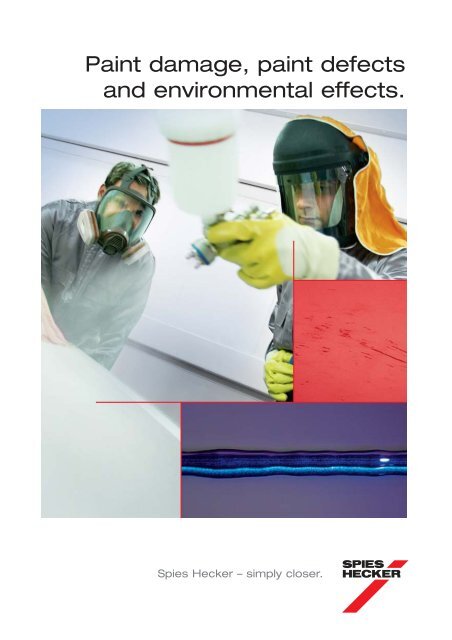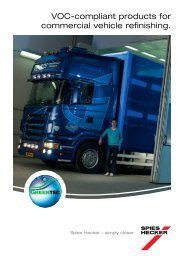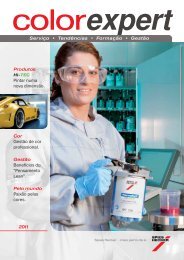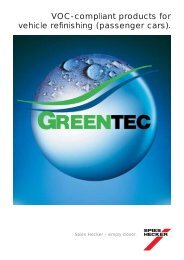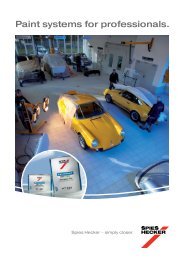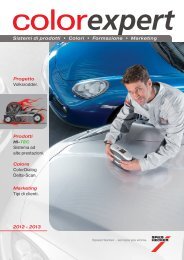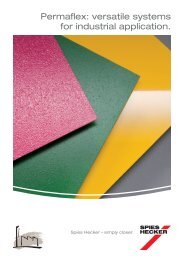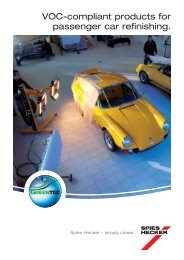Paint damage, paint defects and environmental effects. - Spies Hecker
Paint damage, paint defects and environmental effects. - Spies Hecker
Paint damage, paint defects and environmental effects. - Spies Hecker
Create successful ePaper yourself
Turn your PDF publications into a flip-book with our unique Google optimized e-Paper software.
<strong>Paint</strong> <strong>damage</strong>, <strong>paint</strong> <strong>defects</strong><br />
<strong>and</strong> <strong>environmental</strong> <strong>effects</strong>.<br />
<strong>Spies</strong> <strong>Hecker</strong> – simply closer.
<strong>Paint</strong> <strong>damage</strong>, <strong>paint</strong> <strong>defects</strong><br />
<strong>and</strong> <strong>environmental</strong> <strong>effects</strong>.<br />
The examples <strong>and</strong> suggestions in this booklet are intended to<br />
help you prevent <strong>paint</strong> <strong>defects</strong>, identify <strong>environmental</strong> <strong>effects</strong><br />
<strong>and</strong> produce nothing but immaculate <strong>paint</strong> finishes.<br />
We wish you continued success!
Identifying <strong>and</strong> remedying<br />
<strong>paint</strong> <strong>defects</strong> <strong>and</strong><br />
<strong>environmental</strong> <strong>effects</strong>.<br />
Despite careful preparation, advanced application methods <strong>and</strong><br />
the use of high-grade <strong>paint</strong> systems, flaws in a vehicle refinish<br />
can never be entirely excluded. However, a quality <strong>paint</strong>shop today<br />
cannot afford to produce flawed <strong>paint</strong>work.<br />
Eliminating a defect is often troublesome <strong>and</strong> time-consuming.<br />
What are the causes? What mistakes have been made?<br />
How can such mistakes be avoided in future?
<strong>Spies</strong> <strong>Hecker</strong> hopes that this collection of the most frequent<br />
<strong>paint</strong> <strong>defects</strong> will serve the practitioner as a h<strong>and</strong>y reference<br />
source in his daily work.<br />
Only by correctly assessing <strong>defects</strong> is it possible to eliminate the<br />
causes <strong>and</strong> effectively remedy the <strong>damage</strong> to the <strong>paint</strong>ed surface.<br />
In addition, <strong>paint</strong>work may also be <strong>damage</strong>d by a whole range of<br />
<strong>environmental</strong> <strong>effects</strong>, which have to be identified <strong>and</strong> remedied.
Contents.<br />
<strong>Paint</strong> <strong>defects</strong><br />
10 Poor opacity.<br />
12 Dirt inclusions.<br />
14 Orange peel / poor flow.<br />
16 Holograms.<br />
18 Color separation on sealant.<br />
20 Runs.<br />
22 Clouding or mottling in metallic finishes.<br />
24 Solvent popping.<br />
26 Edge mapping.<br />
28 Polyester bleeding.<br />
30 Water spotting.<br />
32 S<strong>and</strong>ing marks.<br />
34 Moisture blistering.<br />
36 Lifting / wrinkling.<br />
38 Pinholes.<br />
40 Matting.<br />
42 Salt <strong>and</strong> pepper effect.<br />
44 Dirt <strong>and</strong> dust in the base coat.<br />
46 Dirt <strong>and</strong> dust in the clear coat.<br />
48 Poor adhesion.<br />
50 Adhesion problems between base coat <strong>and</strong><br />
clear coat.<br />
52 Halo effect in blending areas.
Environmental <strong>effects</strong><br />
56 Bird droppings.<br />
58 Acid rain.<br />
60 Stone chipping.<br />
62 Tree sap.<br />
64 Bug marks.<br />
66 Tar.<br />
68 Industrial fallout.<br />
70 Splashes of lime or cement.<br />
72 Corrosion.<br />
74 Car wash scratches.<br />
76 Color fade / change.<br />
Miscellaneous<br />
80 Plastic film marks.<br />
82 Transport <strong>damage</strong>.
<strong>Paint</strong> <strong>defects</strong>.
Poor opacity.<br />
Definition<br />
Uneven coloration.<br />
Substrate visible through top coat.<br />
10
Cause<br />
Insufficient top coat applied.<br />
<strong>Paint</strong> <strong>defects</strong><br />
Incorrectly produced, uneven substrate (effect finishes).<br />
Prevention<br />
Keep to the film thicknesses specified on the<br />
Technical Data Sheets.<br />
For low-opacity colors, use the specified surfacer.<br />
Spray a neutral-colored substrate.<br />
Remedy<br />
S<strong>and</strong> the surface <strong>and</strong> respray.<br />
11
Dirt inclusions.<br />
Definition<br />
Particles projecting through the top coat.<br />
12
Cause<br />
Surface not carefully cleaned.<br />
Faulty ceiling filters.<br />
Pressure in the spray booth too low.<br />
Unsuitable work clothes.<br />
Dirty spray booth.<br />
Prevention<br />
Carefully blow off the surface, clean it <strong>and</strong> then<br />
wipe with a tack cloth.<br />
Check filters regularly.<br />
Wear lint-free overalls.<br />
Maintain spray booth regularly.<br />
Remedy<br />
S<strong>and</strong> defect lightly <strong>and</strong> polish.<br />
S<strong>and</strong> <strong>and</strong> respray large surfaces.<br />
<strong>Paint</strong> <strong>defects</strong><br />
13
Orange peel / poor flow.<br />
Definition<br />
Surface texture resembling orange peel.<br />
14
Cause<br />
<strong>Paint</strong> viscosity too high.<br />
Fast, highly volatile reducers.<br />
Incorrect nozzle size.<br />
<strong>Paint</strong> <strong>defects</strong><br />
Spray gun too far from object; not enough <strong>paint</strong> applied.<br />
Prevention<br />
Set the right spray booth temperature.<br />
Adapt the <strong>paint</strong> system to the repair job <strong>and</strong><br />
spray booth temperature.<br />
Set the right <strong>paint</strong> viscosity with a DIN viscosity cup.<br />
Check <strong>and</strong> maintain spraying distance<br />
(follow spray gun manufacturer’s recommendations).<br />
Remedy<br />
On small surfaces, s<strong>and</strong>ing <strong>and</strong> polishing are possible.<br />
On large surfaces, s<strong>and</strong> down the texture <strong>and</strong> respray.<br />
15
Holograms.<br />
Definition<br />
3D effect on dark <strong>paint</strong> surfaces on which a <strong>paint</strong> defect<br />
has been remedied.<br />
Mostly elliptical or circular clouding;<br />
greyish iridescence like that of an oil film.<br />
16
Cause<br />
<strong>Paint</strong> <strong>defects</strong><br />
Remedying of <strong>defects</strong> <strong>and</strong> dust nibs on mostly dark top coats<br />
or clear coats.<br />
Prevention<br />
Use products specified by polish manufacturer.<br />
Use suitable s<strong>and</strong>ing materials.<br />
Keep to the drying times for the <strong>paint</strong> systems employed.<br />
Follow instructions on the Technical Data Sheets.<br />
Remedy<br />
Treat surface again with suitable polishes.<br />
17
Color separation on sealant.<br />
Definition<br />
Sealant visible through top coat.<br />
18
Cause<br />
Sealant over<strong>paint</strong>ed too soon.<br />
Insufficient wetting of top coat on sealant.<br />
Prevention<br />
Allow enough time for sealant to dry.<br />
Apply a thin initial coat of base / top coat over seals.<br />
Remedy<br />
Respray.<br />
<strong>Paint</strong> <strong>defects</strong><br />
19
Runs.<br />
Definition<br />
<strong>Paint</strong> runs on vertical body parts.<br />
20
Cause<br />
Uneven <strong>paint</strong> application.<br />
Specified spray viscosity not observed.<br />
Unsuitable reducers.<br />
Material or spray booth temperature too low.<br />
Film thicknesses too high.<br />
Faulty spray gun (nozzle).<br />
Flash-off between coats too short.<br />
Prevention<br />
<strong>Paint</strong> <strong>defects</strong><br />
Comply with instructions on object, <strong>paint</strong> <strong>and</strong> spray booth<br />
temperature.<br />
Check spraying equipment regularly.<br />
Mix <strong>and</strong> apply <strong>paint</strong> in accordance with the instructions on<br />
the Technical Data Sheets.<br />
Remedy<br />
After the specified drying time, flat any runs.<br />
If necessary, use an infrared heater for further drying <strong>and</strong><br />
then polish.<br />
If the runs have been s<strong>and</strong>ed right through, respray.<br />
21
Clouding or mottling in<br />
metallic finishes.<br />
Definition<br />
Uneven color / effect.<br />
22
Cause<br />
Faulty spray gun (nozzle).<br />
<strong>Paint</strong> <strong>defects</strong><br />
Incorrect air pressure, unsuitable reducer,<br />
unsuitable spraying technique, unsuitable spray viscosity.<br />
Prevention<br />
Use mixing stick or DIN viscosity cup to obtain spray viscosity.<br />
Maintain spray guns regularly.<br />
Hold spray gun parallel to object while spraying<br />
(observe correct distance).<br />
Follow the spray gun manufacturer’s instructions.<br />
Follow the application recommendations on the<br />
Technical Data Sheets.<br />
Remedy<br />
Allow clear coat to dry thoroughly, then s<strong>and</strong> the surface<br />
<strong>and</strong> respray.<br />
23
Solvent popping.<br />
Definition<br />
Small bubbles in the top coat, some of them burst.<br />
24
Cause<br />
Excessive film thickness.<br />
Top coat not allowed to flash off long enough before<br />
forced drying.<br />
Specified spray viscosity not observed.<br />
Unsuitable hardener or reducer.<br />
Prevention<br />
Apply <strong>paint</strong> in normal film thicknesses.<br />
Keep to specified flash-off times.<br />
<strong>Paint</strong> <strong>defects</strong><br />
Follow the instructions on spray viscosity, hardeners <strong>and</strong><br />
reducers on the Technical Data Sheets.<br />
Remedy<br />
S<strong>and</strong> the affected areas lightly with a s<strong>and</strong>ing pad <strong>and</strong><br />
respray within 24 hours.<br />
Do not s<strong>and</strong> pop marks open.<br />
Where there are large bubbles / pop marks, s<strong>and</strong> down<br />
the surface completely <strong>and</strong> reapply the <strong>paint</strong> system.<br />
25
Edge mapping.<br />
Definition<br />
Edges showing through in the top coat.<br />
26
Cause<br />
<strong>Paint</strong> <strong>defects</strong><br />
Old <strong>paint</strong>work not s<strong>and</strong>ed down smoothly at the edges.<br />
Putty <strong>and</strong> surfacer applied on top of elastic factory finish.<br />
Surfacer s<strong>and</strong>ed <strong>and</strong> recoated before it had fully dried.<br />
Substrate not completely dry.<br />
Priming material applied in excessive film thickness <strong>and</strong><br />
not allowed to dry properly.<br />
Prevention<br />
Carry out a solvent test on the substrate (elastic / hard).<br />
Apply putty to bare metal only.<br />
On elastic substrates apply surfacer to complete panels.<br />
Remedy<br />
After the top coat has fully dried, fine-s<strong>and</strong> <strong>and</strong> polish.<br />
S<strong>and</strong>, isolate with a surfacer <strong>and</strong> spray again.<br />
27
Polyester bleeding.<br />
Definition<br />
Discolored patches in metallic finishes.<br />
28
Cause<br />
Too much hardener in the polyester putty.<br />
Prevention<br />
Isolate areas of putty with suitable materials.<br />
If necessary, use putty dispenser.<br />
Avoid using excessive hardener in the putty.<br />
Remedy<br />
If too much hardener was used in polyester putty,<br />
s<strong>and</strong> off polyester putty <strong>and</strong> repeat application using<br />
correct putty / hardener ratio.<br />
<strong>Paint</strong> <strong>defects</strong><br />
29
Water spotting.<br />
Definition<br />
Marks <strong>and</strong> raised edges of water droplets on fresh finishes.<br />
30
Cause<br />
Warm, not fully hardened top coat spotted with<br />
water droplets, usually immediately after oven drying.<br />
Prevention<br />
Observe drying time.<br />
Allow object to cool after oven drying.<br />
Remedy<br />
Lightly s<strong>and</strong> <strong>and</strong> polish.<br />
S<strong>and</strong> <strong>damage</strong>d area <strong>and</strong> respray.<br />
<strong>Paint</strong> <strong>defects</strong><br />
31
S<strong>and</strong>ing marks.<br />
Definition<br />
S<strong>and</strong>ing marks with swollen edges.<br />
32
Cause<br />
Excessively coarse s<strong>and</strong>ing materials for<br />
substrate preparation.<br />
Prevention<br />
S<strong>and</strong> putty with P 120-180 (initial s<strong>and</strong>ing) <strong>and</strong><br />
P 240-320 (final s<strong>and</strong>ing).<br />
Surfacer: dry P 400-500, wet P 800-1200.<br />
Follow instructions for substrate preparation on the<br />
Technical Data Sheets.<br />
Remedy<br />
<strong>Paint</strong> <strong>defects</strong><br />
When the top coat has fully dried, fine-s<strong>and</strong> <strong>and</strong> polish<br />
the <strong>paint</strong> surface.<br />
To eliminate serious <strong>damage</strong>, s<strong>and</strong> <strong>paint</strong> surface <strong>and</strong><br />
respray.<br />
33
Moisture blistering.<br />
Definition<br />
Small raised pimples appearing in the <strong>paint</strong> film.<br />
34
Cause<br />
Moisture absorbed by the substrate.<br />
Insufficient substrate drying after wet s<strong>and</strong>ing<br />
(particularly a problem with polyester products).<br />
Condensation due to temperature fluctuations.<br />
Polyester products not isolated.<br />
Damp compressed air.<br />
Prevention<br />
Dry-s<strong>and</strong> <strong>and</strong> isolate polyester products.<br />
Ensure that the supplied compressed air is clean.<br />
Remedy<br />
<strong>Paint</strong> <strong>defects</strong><br />
S<strong>and</strong> down the affected area completely, matt-s<strong>and</strong> the<br />
unaffected remaining surface, clean with silicone remover,<br />
apply surfacer <strong>and</strong> then respray.<br />
35
Lifting / wrinkling.<br />
Definition<br />
Lifting / wrinkling of the <strong>paint</strong> surface.<br />
36
Cause<br />
Substrate solvent-sensitive or not fully cured.<br />
<strong>Paint</strong> <strong>defects</strong><br />
Areas where clear coat was s<strong>and</strong>ed through to base coat<br />
either not isolated or isolated with an unsuitable surfacer.<br />
Unsuitable substrate<br />
(e.g. aerosol-can finish with TPA or nitrocellulose <strong>paint</strong>s).<br />
Unsuitable priming materials, top coats or reducers.<br />
Prevention<br />
Carry out a solvent test on problem substrates.<br />
Apply several thin coats of a 2K surfacer to problem substrates<br />
<strong>and</strong> allow longer flash-off.<br />
Remedy<br />
Completely remove the fully dried area of wrinkled top coat<br />
together with the affected substrate <strong>and</strong> apply the <strong>paint</strong><br />
system again.<br />
Before applying the top coat, lightly s<strong>and</strong> the entire area.<br />
37
Pinholes.<br />
Definition<br />
Small, pinhole-like depressions.<br />
38
Cause<br />
Air trapped in putty.<br />
Excessive putty film thickness.<br />
Incorrect spray viscosity for surfacer materials.<br />
Excessive surfacer film thickness.<br />
Insufficient flash-off between coats.<br />
Prevention<br />
Follow the application recommendations on the<br />
Technical Data Sheets.<br />
Choose the right hardener for the temperature.<br />
Observe flash-off times.<br />
Remedy<br />
S<strong>and</strong> down pinholes, apply surfacer if necessary <strong>and</strong><br />
reapply <strong>paint</strong> system.<br />
<strong>Paint</strong> <strong>defects</strong><br />
39
Matting.<br />
Definition<br />
Loss of top coat gloss.<br />
40
Cause<br />
Surfacer not allowed to dry properly.<br />
Unsuitable reducers or hardeners.<br />
Hardener had already reacted with moisture.<br />
Poor air circulation in drying oven.<br />
Extraordinary climatic conditions.<br />
Film thickness too high or low.<br />
Prevention<br />
Keep to the<br />
• drying times <strong>and</strong><br />
• film thicknesses<br />
specified on the Technical Data Sheets.<br />
Use only the recommended reducers.<br />
Close hardener cans immediately after use.<br />
Check air circulation in drying oven.<br />
Remedy<br />
After drying, polish the affected area to a full gloss or,<br />
alternatively, lightly s<strong>and</strong> the whole surface,<br />
clean with silicone remover <strong>and</strong> respray.<br />
<strong>Paint</strong> <strong>defects</strong><br />
41
Salt <strong>and</strong> pepper effect.<br />
Definition<br />
Black <strong>and</strong> white stippling / impurities in the base coat.<br />
42
Cause<br />
Material insufficiently filtered.<br />
<strong>Paint</strong> <strong>defects</strong><br />
Incorrect storage temperature (waterborne base coat).<br />
Material past end of shelf life.<br />
Insufficiently stirred base coat.<br />
Prevention<br />
Use a suitable strainer.<br />
Observe storage temperature<br />
(as given on the Technical Data Sheets).<br />
Stir the tinters in the mixing machine regularly.<br />
Remedy<br />
S<strong>and</strong> <strong>and</strong> respray with uncontaminated material.<br />
43
Dirt <strong>and</strong> dust in the base coat.<br />
Definition<br />
Dirt particles projecting from the base coat.<br />
44
Cause<br />
Base coat not filtered.<br />
<strong>Paint</strong> <strong>defects</strong><br />
Incorrect cleaning of the surface (dirt from rebates, etc.).<br />
Dirt from clothing (refinisher).<br />
Unsuitable tack cloth / dirty spray booth <strong>and</strong> filters<br />
(ceiling, floor).<br />
Prevention<br />
Filter base coat.<br />
Clean surface correctly (including rebates, etc.).<br />
Wear clean overalls.<br />
Use suitable tack cloth.<br />
Maintain the spray booth regularly.<br />
Remedy<br />
Clean with silicone remover, tack cloth (s<strong>and</strong> if necessary)<br />
<strong>and</strong> reapply base coat.<br />
45
Dirt <strong>and</strong> dust in the clear coat.<br />
Definition<br />
Dirt particles projecting from the clear coat.<br />
46
Cause<br />
Clear coat not adequately filtered.<br />
<strong>Paint</strong> <strong>defects</strong><br />
Incorrect cleaning of the surface (dirt from rebates, etc.).<br />
Dirt from clothing (refinisher).<br />
Dirty spray booth <strong>and</strong> filters.<br />
Prevention<br />
Filter clear coat well.<br />
Clean surface correctly (including rebates, etc.).<br />
Wear clean overalls.<br />
Maintain the spray booth regularly.<br />
Remedy<br />
S<strong>and</strong> (P 1500) <strong>and</strong> polish.<br />
If exceptionally contaminated, s<strong>and</strong> <strong>and</strong> then respray<br />
base coat <strong>and</strong> clear coat.<br />
47
Poor adhesion.<br />
Definition<br />
Loss of putty adhesion on bare metal<br />
(steel, zinc or aluminum).<br />
48
Cause<br />
Unsuitable substrate.<br />
Putty overheating during IR drying.<br />
Insufficient substrate preparation.<br />
Prevention<br />
Choose suitable putty for the substrate.<br />
Observe distance from heater.<br />
Choose correct preparation.<br />
Remedy<br />
S<strong>and</strong> down <strong>and</strong> start again.<br />
<strong>Paint</strong> <strong>defects</strong><br />
49
Adhesion problems between<br />
base coat <strong>and</strong> clear coat.<br />
Definition<br />
Poor adhesion between base coat <strong>and</strong> clear coat.<br />
Clear coat peels off.<br />
50
Cause<br />
Insufficient flash-off before clear coat application.<br />
Base coat film too thick.<br />
Prevention<br />
Observe flash-off times<br />
(follow instructions on the Technical Data Sheets).<br />
Observe film thicknesses<br />
(follow instructions on the Technical Data Sheets).<br />
Remedy<br />
S<strong>and</strong> <strong>and</strong> respray.<br />
<strong>Paint</strong> <strong>defects</strong><br />
51
Halo effect in blending areas.<br />
Definition<br />
Visible edge when blending in from the base coat.<br />
52
Cause<br />
Edge zone sprayed too dry / wet.<br />
Incorrect spraying technique.<br />
Spraying pressure too high.<br />
Spray booth temperature too high.<br />
No blend-in additive used.<br />
Prevention<br />
Check spray booth temperature.<br />
<strong>Paint</strong> <strong>defects</strong><br />
Use blend-in additive in accordance with instructions on<br />
the Technical Data Sheets.<br />
Remedy<br />
S<strong>and</strong> clear coat, <strong>and</strong> respray base coat <strong>and</strong> clear coat.<br />
53
Environmental <strong>effects</strong>.
Bird droppings.<br />
Definition<br />
The <strong>damage</strong> can range from <strong>paint</strong> discoloration to the film<br />
dissolving completely.<br />
Bubbling, swelling <strong>and</strong> etching are typical phenomena.<br />
56
Cause<br />
Environmental <strong>effects</strong><br />
The different types of food ingested by birds affect the<br />
composition <strong>and</strong> quantity of droppings.<br />
Chemical aggression on the <strong>paint</strong> surface may be caused<br />
by strong organic acids acting for an extended period <strong>and</strong><br />
exposed to high temperatures.<br />
Remedy<br />
Depending on the type of <strong>damage</strong>, the remedy ranges from<br />
polishing to a complete respray.<br />
57
Acid rain.<br />
Definition<br />
Droplet-like spots with sunken edges or edge zones.<br />
58
Cause<br />
Etching of the <strong>paint</strong> surface by acid rain.<br />
Environmental <strong>effects</strong><br />
Destruction of the <strong>paint</strong> film by the sulphurous acid or<br />
even sulphuric acid contained in acid rain.<br />
Remedy<br />
Repair <strong>paint</strong> surface by polishing.<br />
In the event of severe <strong>damage</strong>, a respray may be necessary.<br />
59
Stone chipping.<br />
Definition<br />
Dot-like, angular or crater-like <strong>damage</strong> to the <strong>paint</strong>.<br />
Tiny impact holes in the <strong>paint</strong> surface.<br />
60
Cause<br />
Environmental <strong>effects</strong><br />
Serious mechanical stressing of the <strong>paint</strong> surface,<br />
particularly at the front of the vehicle.<br />
Small stones or chippings thrown up at the <strong>paint</strong>work<br />
by other vehicles.<br />
Remedy<br />
Local repair is possible with a brush.<br />
If stone chipping is widespread, s<strong>and</strong> <strong>and</strong> replace<br />
<strong>paint</strong> system.<br />
61
Tree sap.<br />
Definition<br />
Thread or droplet-like deposits then can etch deep<br />
into the <strong>paint</strong>work.<br />
62
Cause<br />
Environmental <strong>effects</strong><br />
Chemical aggression from tree sap <strong>and</strong> blossom resin.<br />
Remedy<br />
Remove tree sap carefully, so as not to <strong>damage</strong> the top coat.<br />
Allow cloths soaked in silicone remover to act for some time,<br />
then carefully scrape off the tree sap with a plastic spatula.<br />
Polish (if necessary s<strong>and</strong> <strong>and</strong> polish).<br />
Respray if <strong>damage</strong> is serious.<br />
63
Bug marks.<br />
Definition<br />
Etching of the top coat.<br />
Damage can range from loss of gloss to the complete<br />
dissolving of the top coat down to the surfacer.<br />
64
Cause<br />
Environmental <strong>effects</strong><br />
Insect secretions reacting on exposure to moisture<br />
<strong>and</strong> heat.<br />
Substances allowed to act for a long time.<br />
Remedy<br />
Clean with water or silicone or tar remover.<br />
Polish (if necessary s<strong>and</strong> <strong>and</strong> polish).<br />
If the <strong>damage</strong> cannot be remedied by polishing,<br />
respray.<br />
65
Tar.<br />
Definition<br />
Dark or yellow dot-like marks surrounded by a halo<br />
of discoloration.<br />
66
Cause<br />
Spots of tar diffusing into the <strong>paint</strong> film.<br />
Made worse by lack of care.<br />
Remedy<br />
Environmental <strong>effects</strong><br />
Immediately remove with tar remover or silicone remover<br />
<strong>and</strong> then polish.<br />
If allowed to act for too long, respraying is the only remedy.<br />
67
Industrial fallout.<br />
Definition<br />
Particles of rust locally visible on the top coat.<br />
68
Cause<br />
Environmental <strong>effects</strong><br />
Chemical destruction of the <strong>paint</strong> film by the corrosion<br />
of individual rust particles on the <strong>paint</strong> film.<br />
Remedy<br />
Depending on the extent of the chemical reaction,<br />
polish (or s<strong>and</strong> <strong>and</strong> polish).<br />
Chemical remedy possible<br />
(please contact our Technical Service).<br />
Respray in the event of serious <strong>damage</strong>.<br />
69
Splashes of lime or cement.<br />
Definition<br />
Matted surfaces with bright, whitish marks.<br />
Etched areas on the <strong>paint</strong> surface.<br />
70
Cause<br />
Environmental <strong>effects</strong><br />
Chemical destruction of the <strong>paint</strong> film by splashes<br />
of lime or cement.<br />
Remedy<br />
Depending on the extent of the <strong>damage</strong>,<br />
polish (or s<strong>and</strong> <strong>and</strong> polish).<br />
Respray if polishing does not help.<br />
71
Corrosion.<br />
Definition<br />
Mechanical <strong>damage</strong> with rust beneath the <strong>paint</strong> film.<br />
72
Cause<br />
Environmental <strong>effects</strong><br />
Stone chipping in conjunction with de-icing salt <strong>and</strong><br />
moisture.<br />
Penetration of moisture into the <strong>damage</strong>d <strong>paint</strong> film.<br />
Bare metal exposed to moisture before priming.<br />
Inadequate vehicle care.<br />
Prevention<br />
Before priming, thoroughly clean <strong>and</strong> degrease<br />
the bare metal.<br />
Remedy<br />
Remove rust from areas of corrosion by s<strong>and</strong>-blasting,<br />
with wire brushes or with CSD cleaning discs.<br />
If the rust is serious, part replacement may be advisable.<br />
Complete new respray.<br />
73
Car wash scratches.<br />
Definition<br />
Uniform <strong>and</strong> almost parallel scuff <strong>and</strong> scratch marks of<br />
varying depth.<br />
Dull <strong>paint</strong> surfaces.<br />
74
Cause<br />
No or insufficient prewash.<br />
Washing with too little water.<br />
Wash brushes worn or dirty.<br />
Remedy<br />
Mechanical polishing.<br />
Sealing the <strong>paint</strong> surface with hard wax.<br />
Proper car care.<br />
Environmental <strong>effects</strong><br />
75
Color fade / change.<br />
Definition<br />
White, light-colored, pale surfaces, mostly horizontal.<br />
Staining with discolored spots.<br />
76
Cause<br />
Environmental <strong>effects</strong><br />
Destruction of the <strong>paint</strong> pigment by UV radiation <strong>and</strong><br />
weathering.<br />
Remedy<br />
Respray.<br />
Recommended is a solid-color 2-coat system.<br />
77
Miscellaneous.
Plastic film marks.<br />
Definition<br />
Plastic film contact marks are clearly visible.<br />
Remains of film adhesive.<br />
80
Cause<br />
Plastic film placed too soon over <strong>paint</strong>work<br />
that was not completely dry.<br />
Prevention<br />
Vapor-diffusing film should be used.<br />
Miscellaneous<br />
Follow the instructions of the plastic film manufacturer.<br />
Remedy<br />
Remove remains of adhesive with silicone remover<br />
or other mild cleaners.<br />
Then polish.<br />
If necessary, s<strong>and</strong> surfaces <strong>and</strong> respray.<br />
81
Transport <strong>damage</strong>.<br />
Definition<br />
Scratch marks of varying depth.<br />
82
Cause<br />
Miscellaneous<br />
Insufficient protection of factory finish during improper<br />
transport.<br />
Prevention<br />
Covering the original <strong>paint</strong>work<br />
(plastic film or protective <strong>paint</strong>).<br />
Remedy<br />
S<strong>and</strong> shallow scratches <strong>and</strong> polish.<br />
Deeper scratches require a refinish.<br />
83
<strong>Spies</strong> <strong>Hecker</strong> GmbH<br />
Horbeller Str. 17<br />
D-50858 Köln<br />
Tel.: +49 (0) 2234 6019-4050<br />
Fax: +49 (0) 2234 6019-4100<br />
www.spieshecker.com


